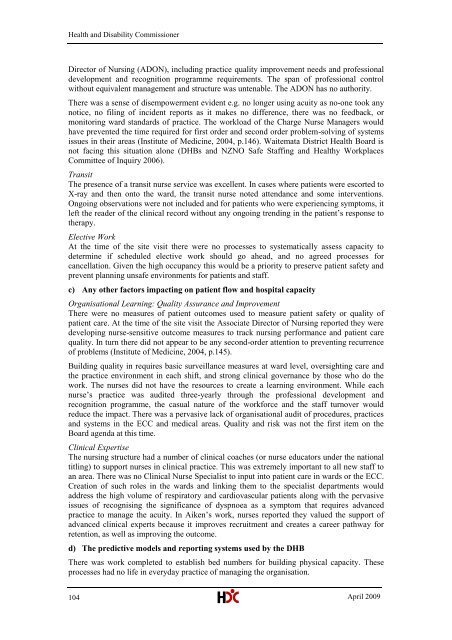North Shore Hospital report - New Zealand Doctor
North Shore Hospital report - New Zealand Doctor
North Shore Hospital report - New Zealand Doctor
You also want an ePaper? Increase the reach of your titles
YUMPU automatically turns print PDFs into web optimized ePapers that Google loves.
Health and Disability CommissionerDirector of Nursing (ADON), including practice quality improvement needs and professionaldevelopment and recognition programme requirements. The span of professional controlwithout equivalent management and structure was untenable. The ADON has no authority.There was a sense of disempowerment evident e.g. no longer using acuity as no-one took anynotice, no filing of incident <strong>report</strong>s as it makes no difference, there was no feedback, ormonitoring ward standards of practice. The workload of the Charge Nurse Managers wouldhave prevented the time required for first order and second order problem-solving of systemsissues in their areas (Institute of Medicine, 2004, p.146). Waitemata District Health Board isnot facing this situation alone (DHBs and NZNO Safe Staffing and Healthy WorkplacesCommittee of Inquiry 2006).TransitThe presence of a transit nurse service was excellent. In cases where patients were escorted toX-ray and then onto the ward, the transit nurse noted attendance and some interventions.Ongoing observations were not included and for patients who were experiencing symptoms, itleft the reader of the clinical record without any ongoing trending in the patient‘s response totherapy.Elective WorkAt the time of the site visit there were no processes to systematically assess capacity todetermine if scheduled elective work should go ahead, and no agreed processes forcancellation. Given the high occupancy this would be a priority to preserve patient safety andprevent planning unsafe environments for patients and staff.c) Any other factors impacting on patient flow and hospital capacityOrganisational Learning: Quality Assurance and ImprovementThere were no measures of patient outcomes used to measure patient safety or quality ofpatient care. At the time of the site visit the Associate Director of Nursing <strong>report</strong>ed they weredeveloping nurse-sensitive outcome measures to track nursing performance and patient carequality. In turn there did not appear to be any second-order attention to preventing recurrenceof problems (Institute of Medicine, 2004, p.145).Building quality in requires basic surveillance measures at ward level, oversighting care andthe practice environment in each shift, and strong clinical governance by those who do thework. The nurses did not have the resources to create a learning environment. While eachnurse‘s practice was audited three-yearly through the professional development andrecognition programme, the casual nature of the workforce and the staff turnover wouldreduce the impact. There was a pervasive lack of organisational audit of procedures, practicesand systems in the ECC and medical areas. Quality and risk was not the first item on theBoard agenda at this time.Clinical ExpertiseThe nursing structure had a number of clinical coaches (or nurse educators under the nationaltitling) to support nurses in clinical practice. This was extremely important to all new staff toan area. There was no Clinical Nurse Specialist to input into patient care in wards or the ECC.Creation of such roles in the wards and linking them to the specialist departments wouldaddress the high volume of respiratory and cardiovascular patients along with the pervasiveissues of recognising the significance of dyspnoea as a symptom that requires advancedpractice to manage the acuity. In Aiken‘s work, nurses <strong>report</strong>ed they valued the support ofadvanced clinical experts because it improves recruitment and creates a career pathway forretention, as well as improving the outcome.d) The predictive models and <strong>report</strong>ing systems used by the DHBThere was work completed to establish bed numbers for building physical capacity. Theseprocesses had no life in everyday practice of managing the organisation.104April 2009
















